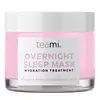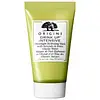What's inside
What's inside
 Key Ingredients
Key Ingredients

 Benefits
Benefits

 Concerns
Concerns

 Ingredients Side-by-side
Ingredients Side-by-side

Aloe Barbadensis Leaf Juice
Skin ConditioningGlycerin
HumectantNeopentyl Glycol Diheptanoate
EmollientIsododecane
EmollientBrassica Oleracea Italica Seed Oil
EmollientNiacinamide
SmoothingPelargonium Graveolens Oil
MaskingPyrus Malus Fruit Extract
Skin ConditioningSodium Hyaluronate
HumectantDaucus Carota Sativa Seed Oil
EmollientTocopheryl Acetate
AntioxidantUbiquinone
AntioxidantVaccinium Myrtillus Fruit/Leaf Extract
AstringentDodecylxylylditrimonium Chloride
Ascorbic Acid
AntioxidantFerulic Acid
AntimicrobialButyrospermum Parkii Nut Extract
EmollientSqualane
EmollientClitoria Ternatea Fruit Extract
Skin ConditioningMica
Cosmetic ColorantEnteromorpha Compressa Extract
Skin ProtectingCurcuma Longa Root
Skin ConditioningQuercetin
AntioxidantCamellia Sinensis Leaf Extract
AntimicrobialEthylhexylglycerin
Skin ConditioningAloe Barbadensis Leaf Juice, Glycerin, Neopentyl Glycol Diheptanoate, Isododecane, Brassica Oleracea Italica Seed Oil, Niacinamide, Pelargonium Graveolens Oil, Pyrus Malus Fruit Extract, Sodium Hyaluronate, Daucus Carota Sativa Seed Oil, Tocopheryl Acetate, Ubiquinone, Vaccinium Myrtillus Fruit/Leaf Extract, Dodecylxylylditrimonium Chloride, Ascorbic Acid, Ferulic Acid, Butyrospermum Parkii Nut Extract, Squalane, Clitoria Ternatea Fruit Extract, Mica, Enteromorpha Compressa Extract, Curcuma Longa Root, Quercetin, Camellia Sinensis Leaf Extract, Ethylhexylglycerin
Water
Skin ConditioningGlycerin
HumectantCetyl Alcohol
EmollientGlyceryl Polymethacrylate
Niacinamide
SmoothingHydroxyethyl Urea
HumectantPEG-75
HumectantDimethicone
EmollientPersea Gratissima Oil
Skin ConditioningPPG-15 Stearyl Ether
EmollientPEG-8
HumectantGlycereth-26
HumectantSorbitan Stearate
EmulsifyingCitrus Aurantium Amara Leaf/Twig Oil
MaskingCitrus Aurantium Dulcis Peel Oil
MaskingRicinus Communis Seed Oil
MaskingOsmanthus Fragrans Flower Extract
MaskingRosa Damascena Extract
MaskingRibes Nigrum Bud Extract
PerfumingCinnamomum Camphora Leaf Extract
MaskingBenzaldehyde
MaskingHexenyl Acetate
MaskingGamma-Decalactone
PerfumingIonone
AstringentEthyl Acetate
PerfumingAlcohol
AntimicrobialLinalool
PerfumingLimonene
PerfumingIsopropyl Isostearate
EmollientPEG-100 Stearate
Citrus Aurantium Dulcis Peel Wax
Skin ConditioningPrunus Armeniaca Kernel Oil
MaskingMangifera Indica Seed Butter
Skin ConditioningSucrose
HumectantHypnea Musciformis Extract
Skin ProtectingAvena Sativa Kernel Extract
AbrasiveTriticum Vulgare Bran Extract
Skin ConditioningCladosiphon Okamuranus Extract
Skin ConditioningCetearyl Alcohol
EmollientCaffeine
Skin ConditioningOryza Sativa Extract
AbsorbentGelidiella Acerosa Extract
Skin ProtectingButylene Glycol
HumectantAloe Barbadensis Leaf Extract
EmollientPantethine
EmollientOlea Europaea Fruit Extract
BleachingCocos Nucifera Oil
MaskingPunica Granatum Sterols
Skin ConditioningSorbitol
HumectantCaprylyl Glycol
EmollientTocopheryl Acetate
AntioxidantOryzanol
Skin ConditioningTrehalose
HumectantBisabolol
MaskingCetyl Ethylhexanoate
EmollientSodium Hyaluronate
HumectantCarbomer
Emulsion StabilisingHexylene Glycol
EmulsifyingPotassium Hydroxide
BufferingDextrin
AbsorbentDisodium EDTA
Potassium Sorbate
PreservativePhenoxyethanol
PreservativeAquilaria Agallocha Wood Oil
MaskingWater, Glycerin, Cetyl Alcohol, Glyceryl Polymethacrylate, Niacinamide, Hydroxyethyl Urea, PEG-75, Dimethicone, Persea Gratissima Oil, PPG-15 Stearyl Ether, PEG-8, Glycereth-26, Sorbitan Stearate, Citrus Aurantium Amara Leaf/Twig Oil, Citrus Aurantium Dulcis Peel Oil, Ricinus Communis Seed Oil, Osmanthus Fragrans Flower Extract, Rosa Damascena Extract, Ribes Nigrum Bud Extract, Cinnamomum Camphora Leaf Extract, Benzaldehyde, Hexenyl Acetate, Gamma-Decalactone, Ionone, Ethyl Acetate, Alcohol, Linalool, Limonene, Isopropyl Isostearate, PEG-100 Stearate, Citrus Aurantium Dulcis Peel Wax, Prunus Armeniaca Kernel Oil, Mangifera Indica Seed Butter, Sucrose, Hypnea Musciformis Extract, Avena Sativa Kernel Extract, Triticum Vulgare Bran Extract, Cladosiphon Okamuranus Extract, Cetearyl Alcohol, Caffeine, Oryza Sativa Extract, Gelidiella Acerosa Extract, Butylene Glycol, Aloe Barbadensis Leaf Extract, Pantethine, Olea Europaea Fruit Extract, Cocos Nucifera Oil, Punica Granatum Sterols, Sorbitol, Caprylyl Glycol, Tocopheryl Acetate, Oryzanol, Trehalose, Bisabolol, Cetyl Ethylhexanoate, Sodium Hyaluronate, Carbomer, Hexylene Glycol, Potassium Hydroxide, Dextrin, Disodium EDTA, Potassium Sorbate, Phenoxyethanol, Aquilaria Agallocha Wood Oil
 Reviews
Reviews

Alternatives
Ingredients Explained
These ingredients are found in both products.
Ingredients higher up in an ingredient list are typically present in a larger amount.
Glycerin is already naturally found in your skin. It helps moisturize and protect your skin.
A study from 2016 found glycerin to be more effective as a humectant than AHAs and hyaluronic acid.
As a humectant, it helps the skin stay hydrated by pulling moisture to your skin. The low molecular weight of glycerin allows it to pull moisture into the deeper layers of your skin.
Hydrated skin improves your skin barrier; Your skin barrier helps protect against irritants and bacteria.
Glycerin has also been found to have antimicrobial and antiviral properties. Due to these properties, glycerin is often used in wound and burn treatments.
In cosmetics, glycerin is usually derived from plants such as soybean or palm. However, it can also be sourced from animals, such as tallow or animal fat.
This ingredient is organic, colorless, odorless, and non-toxic.
Glycerin is the name for this ingredient in American English. British English uses Glycerol/Glycerine.
Learn more about GlycerinNiacinamide is a multitasking form of vitamin B3 that strengthens the skin barrier, reduces pores and dark spots, regulates oil, and improves signs of aging.
And the best part? It's gentle and well-tolerated by most skin types, including sensitive and reactive skin.
You might have heard of "niacin flush", or the reddening of skin that causes itchiness. Niacinamide has not been found to cause this.
In very rare cases, some individuals may not be able to tolerate niacinamide at all or experience an allergic reaction to it.
If you are experiencing flaking, irritation, and dryness with this ingredient, be sure to double check all your products as this ingredient can be found in all categories of skincare.
When incorporating niacinamide into your routine, look out for concentration amounts. Typically, 5% niacinamide provides benefits such as fading dark spots. However, if you have sensitive skin, it is better to begin with a smaller concentration.
When you apply niacinamide to your skin, your body converts it into nicotinamide adenine dinucleotide (NAD). NAD is an essential coenzyme that is already found in your cells as "fuel" and powers countless biological processes.
In your skin, NAD helps repair cell damage, produce new healthy cells, support collagen production, strengthen the skin barrier, and fight environmental stressors (like UV and pollution).
Our natural NAD levels start to decline with age, leading to slower skin repair, visible aging, and a weaker skin barrier. By providing your skin niacinamide, you're recharging your skin's NAD levels. This leads to stronger, healthier, and younger looking skin.
Another name for vitamin B3 is nicotinamide. This vitamin is water-soluble and our bodies don't store it. We obtain Vitamin B3 from either food or skincare. Meat, fish, wheat, yeast, and leafy greens contain vitamin B3.
The type of niacinamide used in skincare is synthetically created.
Learn more about NiacinamideSodium Hyaluronate is hyaluronic acid's salt form. It is commonly derived from the sodium salt of hyaluronic acid.
Like hyaluronic acid, it is great at holding water and acts as a humectant. This makes it a great skin hydrating ingredient.
Sodium Hyaluronate is naturally occurring in our bodies and is mostly found in eye fluid and joints.
These are some other common types of Hyaluronic Acid:
Learn more about Sodium HyaluronateTocopheryl Acetate is AKA Vitamin E. It is an antioxidant and protects your skin from free radicals. Free radicals damage the skin by breaking down collagen.
One study found using Tocopheryl Acetate with Vitamin C decreased the number of sunburned cells.
Tocopheryl Acetate is commonly found in both skincare and dietary supplements.
Learn more about Tocopheryl Acetate